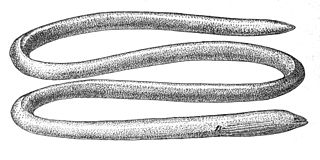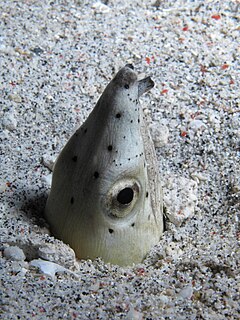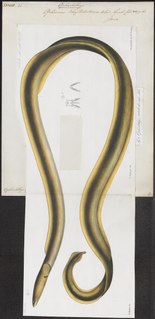Echidna delicatula, the mottled moray, also known as the fine-speckled moray, is a moray eel. It was described by Johann Jakob Kaup in 1856, originally under the genus Poecilophis. It is a marine, tropical eel which is known from the Indo-Pacific, including Sri Lanka, Samoa, and Japan. It inhabits coral reefs. It can reach a maximum total length of 65 centimetres (26 in).

Ophichthus is a genus of eels in the snake eel family Ophichthidae.
The Celebes longfin eel is an eel in the family Anguillidae. It was described by Johann Jakob Kaup in 1856. It is a tropical eel known from freshwaters in the Western Pacific, including Indonesia, the Philippines, New Guinea, and Western and American Samoa. The eels spend most of their lives in freshwater but migrate to the ocean to breed. Males can reach a maximum total length of 150 centimetres.
The Polynesian longfinned eel, also known as the Pacific long-finned eel, is an eel in the family Anguillidae. It was described by Johann Jakob Kaup in 1856. It is a tropical eel found in freshwaters in the Pacific, including Sulawesi, Indonesia; the Society Islands, and Pitcairn. The eels spend most of their lives in freshwater, but migrate to the ocean to breed. Males can reach a maximum total length of 100 centimetres, while females can reach a maximum TL of 165 centimetres and a maximum weight of 9,000 grams.

Moringua bicolor, the bicolor spaghetti eel, is an eel in the family Moringuidae. It was described by Johann Jakob Kaup in 1856. It is a marine eel known from Japan, Indonesia, the Philippines, and the Laccadive Sea, in the Indo-West Pacific. It dwells in temperate waters at a known depth of 3 m (9.8 ft).

The Java spaghetti eel, also known as the Java thrush-eel, Java worm eel, and the black-tailed thrush eel is an eel in the family Moringuidae. It was described by Johann Jakob Kaup in 1856, originally under the genus Aphthalmichthys. It is a tropical, marine eel which is known from the Indo-Pacific, including East Africa, the Tuamoto Islands, the Ryukyu Islands, and Micronesia. It is a burrowing species which inhabits reefs at a depth range of 2–15 m. Males can reach a maximum total length of 120 cm.
Gnathophis capensis, the Southern Atlantic conger or southern conger, is an eel in the family Congridae. It was described by Johann Jakob Kaup in 1856, originally under the genus Leptocephalus. It is a subtropical, marine eel which is known from the southeastern Atlantic Ocean, including from False Bay to Plettenberg Bay, South Africa and also on Tristan da Cunha Island. It is known to dwell at a depth of 100 metres. Males can reach a maximum total length of 37 cm.

Cirrhimuraena chinensis is an eel in the family Ophichthidae. It was described by Johann Jakob Kaup in 1856. It is a tropical, marine eel which is known from China and Papua New Guinea, in the western Pacific Ocean. Males can reach a maximum standard length of 54.8 centimetres.

The highfin snake eel (Ophichthus altipennis, also known as the blackfin snake eel or the black-finned snake eel, is an eel in the family Ophichthidae. It was described by Johann Jakob Kaup in 1856, originally under the genus Microdonophis. It is a marine, tropical eel known from the eastern Indian Ocean and northwestern and western central Pacific Ocean, including Australia, French Polynesia, Indonesia, Japan, the Marshall Islands, Malaysia, the Philippines, and Papua New Guinea. It dwells at a depth range of 0 to 40 m, and forms burrows in soft inshore sand sediments. Males can reach a maximum total length of 103 cm.

The Napoleon snake eel is an eel in the family Ophichthidae. It was described by Johann Jakob Kaup in 1856, originally under the genus Poecilocephalus. It is a marine, tropical eel which is known from the Indo-Pacific, including Durban, South Africa, Mauritius, Indonesia, Japan, Australia, and the Penghu Islands. It is known to dwell at a depth of 20 metres (66 ft), and inhabits lagoons and reefs; it forms solitary burrows in sand sediments. Males can reach a maximum total length of 75 centimetres (30 in).
Ophichthus celebicus is an eel in the family Ophichthidae. It was described by Pieter Bleeker in 1856, originally under the genus Ophisurus. It is a marine, tropical eel which is known from the western Pacific Ocean, including India and Hong Kong.
The dusky snake eel is an eel in the family Ophichthidae. It was described by Camillo Ranzani in 1839. It is a tropical, marine eel which is known from the western Atlantic Ocean, including Cuba and Brazil.
The faintsaddled snake eel is an eel in the family Ophichthidae. It was described by John E. McCosker and Eugenia Brandt Böhlke in 1984. It is a marine, temperate water-dwelling eel which is known from the western central Atlantic Ocean. It is known to dwell at a depth of 108 meters.
The dottedline snake eel is a species of eels in the family Ophichthidae. It was described by John E. McCosker and Eugenia Brandt Böhlke in 1984. It is a marine, temperate water-dwelling eel which is known from the western central Atlantic Ocean. It is known to dwell at a depth of 183 meters.

The palespotted eel is an eel in the family Ophichthidae. It was described by Johann Jakob Kaup in 1859, originally under the genus Cryptopterus. It is a marine, tropical eel which is known from the western Atlantic Ocean, including North Carolina, USA, the northeastern Gulf of Mexico, and Brazil. It dwells at a depth range of 0 to 150 meters, most often at around 5 to 40 meters. Males can reach a maximum total length of 81 centimeters (32 in), but more commonly reach a TL of 60 centimeters (24 in).

The olive snake eel is an eel in the family Ophichthidae. It was described by Pieter Bleeker in 1853, originally under the genus Ophisurus. It is a marine, tropical eel which is known from the Indo-Pacific. It forms burrows in soft sediments in shallow waters, and leads a nocturnal lifestyle. Males can reach a maximum total length of 95 centimetres (37 in).
The Antillian snake eel is an eel in the family Ophichthidae. It was described by John Roxborough Norman in 1922. It is a marine, deep water-dwelling eel which is known from the western central Atlantic Ocean, including Cuba, Puerto Rico, Trinidad-Tobago, and Venezuela. It is known to dwell at a maximum depth of 300 meters, and inhabits coastal waters. Males can reach a maximum total length of 107 centimeters, but more commonly reach a TL of 70 cm.

The Pacific snake-eel is an eel in the family Ophichthidae. It was described by Johann Jakob Kaup in 1856, originally under the genus Muraenopsis. It is a marine, subtropical eel which is known from the eastern central and southeastern Pacific Ocean, including California, USA, Peru, the Gulf of California, Mexico, the Galapagos Islands, Colombia, Ecuador, Costa Rica, El Salvador, Honduras, Guatemala, Nicaragua, and Panama. It dwells at a maximum depth of 155 metres (509 ft), and forms burrows in mud and sand sediments. Males can reach a maximum total length of 115 centimetres (45 in), but more commonly reach a TL of 80 centimetres (31 in).

The manetail snake eel is an eel in the family Ophichthidae. It was described by Coenraad Jacob Temminck and Hermann Schlegel in 1846, originally under the genus Conger. It is a marine, tropical eel which is known from the Indo-Pacific. It inhabits deep waters, but is found in muddy sediments in shallow waters on rare occasions. Males can reach a maximum total length of 61.5 centimetres (24.2 in).
The Kaup's arrowtooth eel is an eel in the family Synaphobranchidae. It was described by James Yate Johnson in 1862. It is a marine, deep water-dwelling eel which is known from the Indo-Western Pacific and eastern and western Atlantic Ocean, including the Faroe Islands, Iceland, Cape Verde, the Western Sahara, Nigeria, Namibia, South Africa, Greenland, France, Saint Pierre and Miquelon, the United Kingdom, Ireland, the Philippines, Portugal, Spain, the Bahamas, Brazil, Canada, Cuba, Japan, Australia, Mauritania, Morocco, and Hawaii. It dwells at a depth range of 120 to 4,800 metres, most often between 400 to 2,200 metres, and inhabits the upper abyssal zone on the continental slope. It is intolerant of the temperatures of higher waters. Males can reach a maximum total length of 100 centimetres (39 in).







